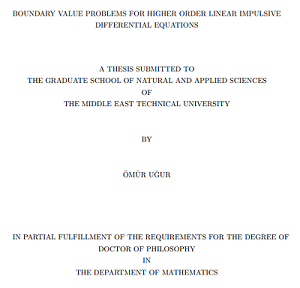Ömür Uğur
Ph.D., Department of Mathematics
August 2003
Supervisor: Prof. Dr. Marat Akhmet (Department of Mathematics, Middle East Technical University, Ankara)
Co-supervisor: Prof. Dr. Hasan Taşeli (Department Mathematics, Middle East Technical University, Ankara)
Abstract
The theory of impulsive differential equations has become an important area of research in recent years. Linear equations, meanwhile, are fundamental in most branches of applied mathematics, science, and technology. The theory of higher order linear impulsive equations, however, has not been studied as much as the corresponding theory of ordinary differential equations.
In this work, higher order linear impulsive equations at fixed moments of impulses together with certain boundary conditions are investigated by making use of a Green’s formula, constructed for piecewise differentiable functions. Existence and uniqueness of solutions of such boundary value problems are also addressed.
Properties of Green’s functions for higher order impulsive boundary value problems are introduced, showing a striking difference when compared to classical boundary value problems of ordinary differential equations. Necessarily, instead of an ordinary Green’s function there corresponds a sequence of Green’s functions due to impulses.
Finally, as a by-product of boundary value problems, eigenvalue problems for higher order linear impulsive differential equations are studied. The conditions for the existence of eigenvalues of linear impulsive operators are presented. Basic properties of eigensolutions of self-adjoint operators are also investigated. In particular, a necessary and sufficient condition for the self-adjointness of Sturm-Liouville operators is given. The corresponding integral equations for boundary value and eigenvalue problems are also demonstrated in the present work.
Keywords: adjoint operators, boundary value problems, eigenvalue problems, Green’s functions, impulsive differential equations, linear operators, Sturm-Liouville systems, theory of differential equations
